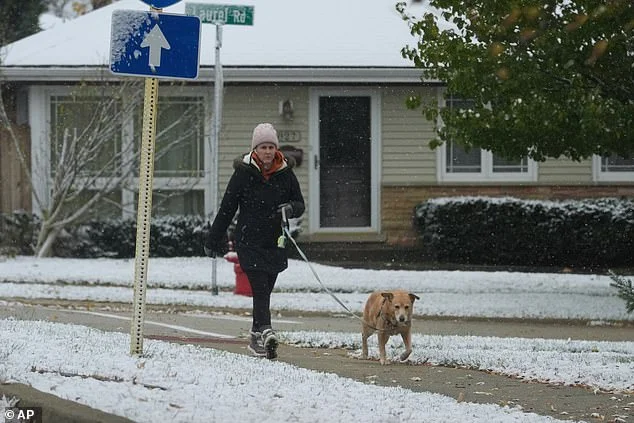More than 155 million Americans are waking up under weather alerts this Monday as an Arctic blast barrels across the country, stretching from the Midwest all the way to the Northeast.
Meteorologists are warning that some areas could experience record-low temperatures, making early November feel more like mid-January.
Bitter Cold Hits Northern States Hard
The brunt of the chill is expected in North Dakota, Minnesota, Wyoming, and West Virginia, where temperatures could dip to 15°F in the coming days.
Cities such as Huntsville, Alabama, and Macon, Georgia, are also bracing for potentially record-breaking cold, with lows forecast at 43°F and 49°F, respectively.
The National Weather Service (NWS) has even issued freeze watches along Alabama’s Gulf Coast, where temperatures could fall below 34°F.
Officials warn that such lows could damage crops and burst unprotected pipes.
The South Feels the Freeze
Even southern states are not immune. The Carolinas and central Florida are expected to shiver through temperatures well below seasonal averages.
Charleston may struggle to reach 50°F—roughly 20 degrees colder than usual—while some Florida cities will barely climb into the 60s.
Morning lows along the Gulf Coast could dip into the 20s, with much of northern and central Florida hovering in the 30s by Tuesday.
Matt Devitt, chief meteorologist at WINK News, humorously noted that local iguanas could even fall from trees as the cold paralyzes them.
“The iguanas are not dead, just temporarily stunned and immobilized from the cold… especially if it drops below 45°. Only in Florida!” he tweeted.
Record-Breaking Lows Loom
This early-November blast could flirt with Veterans Day record lows across several locations.
Savannah, Georgia, and Mobile, Alabama, may see temperatures drop to 31°F, while Ft Myers, Florida, could hit 45°F.
On Tuesday, Atlanta could tie its record low of 26°F, and residents might need to keep faucets dripping to prevent frozen pipes.
Even Orlando and Tampa could experience record-tying temperatures in the upper 30s and low 40s.
The Weather Channel highlighted the severity of the cold, calling it potentially the coldest early November outbreak in Florida and the Southeast in 32 years, tracing back to a November 1993 freeze that gripped Gainesville, Florida, and sent Birmingham, Alabama, plunging to 24°F.
Snow Makes an Early Appearance
This Arctic blast isn’t just bringing frigid air—it’s delivering snow too.
From Michigan’s Upper Peninsula down to the Smoky Mountains, flurries are already falling, with lake-effect snow piling up across the Midwest and Great Lakes.
One heavy snowband dumped 12 inches in just six hours over Momence, Illinois, about 50 miles south of Chicago.
Michigan recorded up to 18 inches south of Marquette and 10 inches on the Leelanau Peninsula north of Traverse City.
Northwest Iowa and southeast South Dakota saw roughly five inches over the weekend, while highs remain locked in the 30s across the southern Appalachians and the 40s from the Northeast down to Alabama, Georgia, and Mississippi.
Cold Advisories Spread Across Florida
Weather alerts extend far south, with most of Florida under cold weather advisories, reaching as far south as Boca Raton, just 45 miles from Miami.
AccuWeather Chief Meteorologist Jonathan Porter explained, “This storm pattern will introduce some of the coldest air seen for early November, which is why we expect robust snow amounts in the Great Lakes and flurries stretching deep into the southern Appalachians.”
Snow Continues Across the Great Lakes and Appalachians
Lake-effect snow near Chicagoland is expected to taper by midday, but heavier bands across Michigan, northern Indiana, and Upper Michigan will persist into the evening.
Tonight, snow shifts southward into the Ohio Valley and Appalachians, with lake-effect bands in the eastern Great Lakes continuing through Tuesday before potentially changing to brief lake rainbands on Wednesday.
Northern New England could see rain change to snow Monday night, with wrap-around snow lingering into Tuesday.
The heaviest accumulations are forecast in the lake snowbelts of northwest Pennsylvania, southwest New York south of Buffalo, New York’s Tug Hill Plateau, northern Vermont’s Green Mountains, and the West Virginia Appalachians, where more than six inches could fall.
Additional inches are expected across the Ohio Valley and western Great Lakes snowbelts, including Michigan, Indiana, Ohio, northern Kentucky, and the Smoky Mountains.
A Widespread Arctic Chill to Remember
From record-breaking lows in the Deep South to early-season snow in the Midwest and Northeast, this Arctic blast is shaping up to be a memorable start to November.
Residents are urged to bundle up, protect vulnerable plants and pipes, and prepare for some truly frosty mornings in the days ahead.
